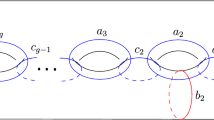Abstract.
The diameter rigidity theorem of Gromoll and Grove [1987] states that a Riemannian manifold with sectional curvature ≥ 1 and diameter ≥ π/2 is either homeomorphic to a sphere, locally isometric to a rank one symmetric space, or it has the cohomology ring of the Cayley plane Caℙ. The reason that they were only able to recognize the cohomology ring of Caℙ is due to an exceptional case in another theorem [Gromoll and Grove, 1988]: A Riemannian submersion σ:?m→B b with connected fibers that is defined on the Euclidean sphere ?m is metrically congruent to a Hopf fibration unless possibly (m,b)=(15,8). We will rule out the exceptional cases in both theorems. Our argument relies on a rather unusal application of Morse theory. For that purpose we give a general criterion which allows to decide whether the Morse index of a closed geodesic is even or odd.
Similar content being viewed by others
Author information
Authors and Affiliations
Additional information
Oblatum 7-II-2000 & 11-X-2000¶Published online: 29 January 2001
Rights and permissions
About this article
Cite this article
Wilking, B. Index parity of closed geodesics and rigidity of Hopf fibrations. Invent. math. 144, 281–295 (2001). https://doi.org/10.1007/PL00005801
Issue Date:
DOI: https://doi.org/10.1007/PL00005801



